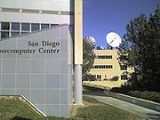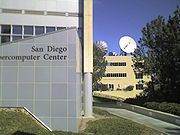
San Diego Supercomputer Center
Encyclopedia

University of California, San Diego
The University of California, San Diego, commonly known as UCSD or UC San Diego, is a public research university located in the La Jolla neighborhood of San Diego, California, United States...
(UCSD). Physically, SDSC is located on the east end of Eleanor Roosevelt College
Eleanor Roosevelt College
Eleanor Roosevelt College is one of the six colleges located on the campus at the University of California, San Diego...
on the campus of UCSD.
Founded in 1985, its self-prescribed mission is "developing and using technology to advance science". SDSC is primarily funded by the National Science Foundation
National Science Foundation
The National Science Foundation is a United States government agency that supports fundamental research and education in all the non-medical fields of science and engineering. Its medical counterpart is the National Institutes of Health...
(NSF) and pursues research in the areas of high performance computing, grid computing
Grid computing
Grid computing is a term referring to the combination of computer resources from multiple administrative domains to reach a common goal. The grid can be thought of as a distributed system with non-interactive workloads that involve a large number of files...
, computational biology
Computational biology
Computational biology involves the development and application of data-analytical and theoretical methods, mathematical modeling and computational simulation techniques to the study of biological, behavioral, and social systems...
, geoinformatics
Geoinformatics
Geoinformatics is the science and the technology which develops and uses information science infrastructure to address the problems of geography, geosciences and related branches of engineering.-Overview:...
, computational physics
Computational physics
Computational physics is the study and implementation of numerical algorithms to solve problems in physics for which a quantitative theory already exists...
, computational chemistry
Computational chemistry
Computational chemistry is a branch of chemistry that uses principles of computer science to assist in solving chemical problems. It uses the results of theoretical chemistry, incorporated into efficient computer programs, to calculate the structures and properties of molecules and solids...
, data management
Data management
Data management comprises all the disciplines related to managing data as a valuable resource.- Overview :The official definition provided by DAMA International, the professional organization for those in the data management profession, is: "Data Resource Management is the development and execution...
, scientific visualization
Scientific visualization
Scientific visualization is an interdisciplinary branch of science according to Friendly "primarily concerned with the visualization of three-dimensional phenomena , where the emphasis is on realistic renderings of volumes, surfaces, illumination sources, and so forth, perhaps...
, and computer networking. SDSC is internationally recognized for its contribution to computational biosciences and computational approaches to earth sciences and genomics. SDSC is especially known for its role in the creation and maintenance of the Protein Data Bank
Protein Data Bank
The Protein Data Bank is a repository for the 3-D structural data of large biological molecules, such as proteins and nucleic acids....
, the George E. Brown, Jr. Network for Earthquake Engineering Simulation Cyberinfrastructure Center (NEESit), cyberinfrastructure for the geosciences (GEON), and the Tree of Life Project (TOL) .
SDSC is one of the four original sites involved in the TeraGrid
TeraGrid
TeraGrid is an e-Science grid computing infrastructure combining resources at eleven partner sites. The project started in 2001 and operated from 2004 through 2011....
project along with National Center for Supercomputing Applications
National Center for Supercomputing Applications
The National Center for Supercomputing Applications is an American state-federal partnership to develop and deploy national-scale cyberinfrastructure that advances science and engineering. NCSA operates as a unit of the University of Illinois at Urbana-Champaign but it provides high-performance...
(NCSA), Argonne National Laboratory
Argonne National Laboratory
Argonne National Laboratory is the first science and engineering research national laboratory in the United States, receiving this designation on July 1, 1946. It is the largest national laboratory by size and scope in the Midwest...
, and Center for Advanced Computing Research (CACR).
SDSC developed the Rocks
Rocks Cluster Distribution
Rocks Cluster Distribution is a Linux distribution intended for high-performance computing clusters. It was started by National Partnership for Advanced Computational Infrastructure and the SDSC in 2000 and was initially funded in part by an NSF grant but is currently funded by the followup NSF...
cluster computing environment, and is a pioneer in data management software development, including the storage resource broker
Storage Resource Broker
Storage Resource Broker is a Data Grid Management System operating in many U.S. and international computational science research projects...
(SRB).
Currently, the director of SDSC is Dr. Michael L. Norman, a distinguished professor of physics at UCSD and a globally recognized astrophysicist who succeeds Dr. Francine Berman, a noted pioneer in grid computing
Grid computing
Grid computing is a term referring to the combination of computer resources from multiple administrative domains to reach a common goal. The grid can be thought of as a distributed system with non-interactive workloads that involve a large number of files...
. He was named director in September 2010, having been the interim director for more than a year.
SDSC is home to the Performance Modeling and Characterization (PMaC) laboratory, whose mission is to bring scientific rigor to the prediction and understanding of factors effecting the performance of current and projected High Performance Computing (HPC) platforms. PMaC is funded by the Department of Energy (SciDac PERC research grant), the Department of Defense (Navy DSRC PET program), DARPA, and the National Science Foundation. Allan E. Snavely, Ph.D., founded the PMaC laboratory in 2001.
In 2009 a combined team from SDSC and Lawrence Berkeley National Labs led by Allan Snavely won the prestigious Data Challenge competition held in Portland Oregon, at SC09, the annual premier conference in High Performance Computing, Networking, Storage and Analysis for their design of a new kind of supercomputer that makes extensive use of flash memory and nicknamed "Dash". Dash is a prototype for a much larger system nicknamed "Gordon" that the team will deploy at SDSC in 2011 with more than 256 TB of flash memory.
SDSC is also home to the Cooperative Association for Internet Data Analysis
Cooperative Association for Internet Data Analysis
The Cooperative Association for Internet Data Analysis is a collaborative undertaking among organizations in the commercial, government, and research sectors aimed at promoting greater cooperation in the engineering and maintenance of a robust, scalable global Internet infrastructure. CAIDA...
(caida), and the Computational and Applied Statistics Laboratory (CASL).
See also
- Library of Congress Digital Library projectLibrary of Congress Digital Library projectThe Library of Congress National Digital Library Program is assembling a digital library of reproductions of primary source materials to support the study of the history and culture of the United States...
- National Digital Information Infrastructure and Preservation ProgramNational Digital Information Infrastructure and Preservation ProgramThe National Digital Information Infrastructure and Preservation Program is an archival program led by the Library of Congress to archive and provide access to digital resources. The U.S. Congress established the program in 2000...

